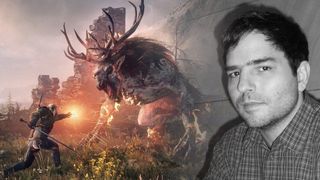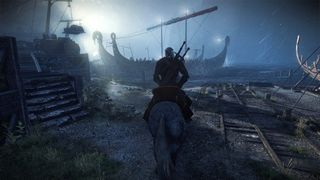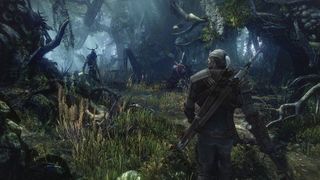The Witcher 3 interview: A good quest isn't about "the sheer number of outcomes"

Back at E3 I saw a 45-minute demonstration of The Witcher 3 (read my thoughts about it here ), which established that this is an exceptionally large open world RPG whose grumpy protagonist travels by land and sea to seek out uncomfortable social situations and stab monsters. In the demo, Geralt did both of those things by playing the brooding stranger in a tragic play about a monster-hounded village and the consequences of taking sides in local politics (lots of murder, it turns out, which made things a bit awkward). " Who's the real monster here? " asks the game.
Executive Producer John Mamais probably can't clear up rhetorical questions or ethical quandaries, but I recently got in a few questions about the demonstration in an e-mail correspondence. The first thing that struck me was the idea that sailing in stormy weather could end with your boat smashed against the rocks, which suggests an exciting level of fidelity. I'm still not clear on whether or not I can sink one, but weather will "affect" boats, according to Mamais.
"Stormy weather, and the heavy winds it brings, will increase the frequency and intensity of waves in larger bodies of water," he says. "It's a real physical simulation. We've got dynamic lighting, which you see in the highly-detailed day and night cycle, and also in beautifully designed and rendered weather effects like uber-authentic rain ... To top it off, you can see changes in the weather coming—you can observe dark clouds on the horizon turn into a big storm."
If a wave does send you into deep water, Geralt "can currently swim as far as he wants," with some exceptions—the ice cold waters of Skellige will kill you after too long. Even Witchers get chilly.

Regarding some technical features, the interface has been redesigned to be a "simpler, transparent and fun experience," says Mamais. "Bear in mind, though, that simple does not mean simplistic," he continues. "We're retaining the depth but cutting out what's unnecessary. As for details—we're experimenting heavily with grid based solutions, while keeping it really flexible and in line with contemporary standards."
The camera system has also been "greatly improved" over The Witcher 2's, with smarter algorithms that know to zoom out for multi-enemy fights and zoom in for "intimate" one-on-one skirmishes. There will not be a first-person view, though I'd be interested to see one eventually patched in along with Oculus Rift support, and I've followed up to see if that might be a future consideration.
At this point, though, my questions turn to the sidequest shown at E3, which I'm calling the "leshen" sidequest, as that's the monster Geralt faces in aid of the terrorized village. You can read all about it in my E3 preview .
PC Gamer Newsletter
Sign up to get the best content of the week, and great gaming deals, as picked by the editors.
In that preview, I lightly criticized the sidequest for relying on cutscenes and interface cues to direct the player—I prefer a more hands-off approach, trusting players to figure out and solve problems with the resources they have—and wondered how complex the branching story really gets. What I take away from Mamais' answers, in general, is that The Witcher 3 is too complex to be summed up in a 45-minute demonstration—one quest isn't necessarily a template for the others.
PC Gamer: Does Geralt have any leisure activities—more of The Witcher 2's minigames?
John Mamais, Executive Producer: We've mentioned knife throwing before but TW3 will include additional mini-games that we don't want to reveal just yet.
We have, though, introduced something entirely new to the series in The Witcher 3 that needs mentioning here—Monster Hunting. It's not exactly a leisure activity but it is an engaging new feature outside of the main quests, something that bolsters the RPG feel and plays into the hardcore nature of the game. Geralt is a witcher and hunting monsters is his main source of income—but in the previous games he was swept from place to place by urgent affairs and didn't really have the time to take on a lot of extra monster-slaying jobs. In The Witcher 3, we're on the road again and hunting monsters is back in the spotlight. The leshen sidequest is a great example of what monster hunts look like—you gather evidence as you try to determine what kind of monster are you dealing with and what its weak spots are. Then, depending on the type of beast, you find its lair or lure it out. We tried really hard to embed each and every monster hunt in the world so they emerge naturally—quite often the monsters are worshipped or feared, there are local legends about them and so on.
In the leshen sidequest, are there more than two possible outcomes? Could we, for example, have warned the marked girl? [The leshen "marked" an innocent villager who had to be driven away or killed before the monster could be hurt.]
At this moment, the leshen quest has three possible endings, one of which entails the monster's death... but that's really beside the point. A good plot should not mimic reality in the sense that you can finish each quest in a million different ways—it's about unexpected twists or the feelings it evokes and not the sheer number of “outcomes.” In general, you don't play games to experience a reality similar to your own, you do it because you want to be thrilled. We're focusing on bringing you really gripping stuff—each subquest in the game feels deep, each choice and its consequences credible and real—that's the main idea we want to convey with The Witcher 3 and we always want to emphasize that. Having said that, we also care about nonlinearity and providing a variety of paths—the previous Witcher games provide ample evidence of that and The Witcher 3 will be no exception.
By the way, about Hilde [the "marked" girl]—we don't want to spoil the fun!

Is that the player's only encounter with a leshen? If not, will later encounters require the player to remember what he or she learned about the marked one and totems [the leshen's defenses], or will encounters always be directed through cutscenes?
The leshen is a creature that inhabits the Witcher universe. It's not exclusive to that quest—it's part of the environment. It's just not as common as your typical, say, nekker. It's similar to how some animals are more or less common, or more likely to be found in certain areas. Leshens are rare and deeply rooted in their terrain—so every encounter with one will be different. Core traits stay the same, though, and everything you learn about leshens and other monsters is recorded for you in the Bestiary. As for other monster hunts, some encounters will be directed through cutscenes and some won't—sometimes we want to ease gamers into a particular story and sometimes we want to surprise them.
How persistent is the world? If Geralt returns to that village after the leshen quest, will we see how our actions changed it?
Yes. After you make your choices and complete the quest, you can revisit the village and see the impact your actions have had on it. At E3 we showed this in the form of an instant flashforward, but normally that's something players would see after several hours of play. Geralt's actions (or his inaction) will visibly impact various NPCs and communities.
Do any sidequest encounters involve large-scale events, such as a town under siege?
We've got quests that cause ripples on a really large scale but these are usually part of the main story arc. Sidequests will resonate with the world on a more intimate level—depending on our decisions villages or specific districts of a city may be affected.

Tyler grew up in Silicon Valley during the '80s and '90s, playing games like Zork and Arkanoid on early PCs. He was later captivated by Myst, SimCity, Civilization, Command & Conquer, all the shooters they call "boomer shooters" now, and PS1 classic Bushido Blade (that's right: he had Bleem!). Tyler joined PC Gamer in 2011, and today he's focused on the site's news coverage. His hobbies include amateur boxing and adding to his 1,200-plus hours in Rocket League.
Most Popular






